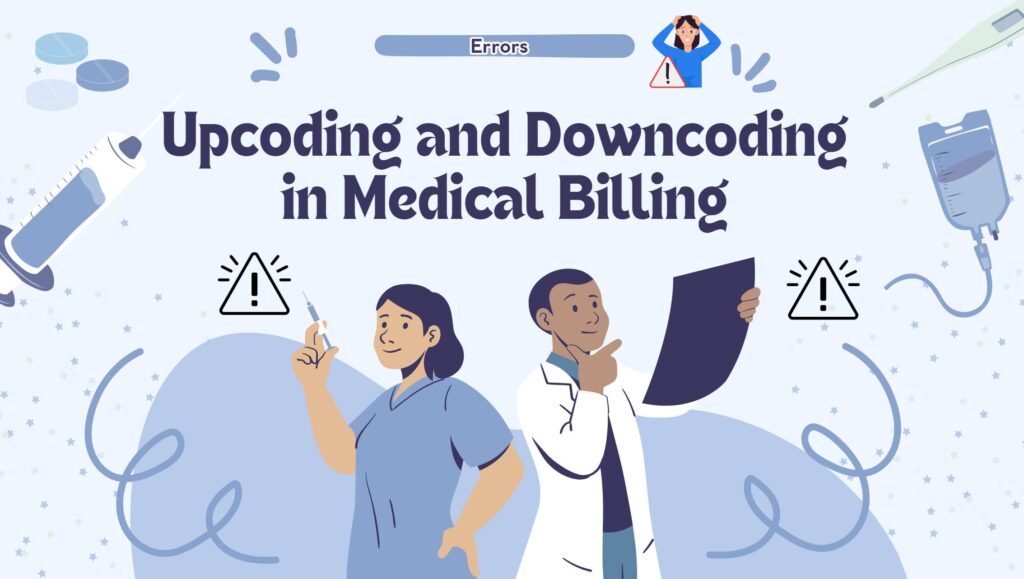When handling a medical bill, the most important first step is to code accurately and precisely. Therefore, in order for practices to be fairly compensated for the medical services they offer to their patients in times of need, they must present an accurate medical bill. Medical records need to be clear and readable throughout, not just for the documenting provider but also for the auditor.
Upcoding and downcoding are terms that are introduced to us in medical coding.
The definitions, variations, and applications of upcoding and downcoding in the context of medical billing are examined here. It is imperative that both payers and providers comprehend terminology to prevent any billing-related issues or delays. Put another way, in order to move further without any problems, a solid grasp of the phrases upcoding and downcoding is required. Downcoded claim appeals need a lot of work and effort. Documentation must be gathered, and providers need to follow up frequently.
Difference Between Upcoding and Downcoding
What does medical payment upcoding mean? Upcoding is the practice of overcharging a patient by marking a code for services that are far more expensive than the actual service rendered. In order to obtain greater reimbursements, many people take advantage of this unwarranted advantage, which ultimately leads to the earning of money through immoral ways.
Many of them are ignorant of the serious legal and financial repercussions that practicing upcoding can have. A healthcare provider who wishes to overcharge a patient may assign a code on the bill for a diagnostic procedure for a more serious health condition than the patient actually has, or for services that are more expensive than what was provided during the visit.
The patient’s insurance company is required to pay an excessive amount of the medical bill that is the result of this practice. In such cases, healthcare providers might try to defend the overcharging, but if found guilty, they could face criminal charges. Even though upcoding is against the law and immoral, it is one of the most prevalent types of fraud in the healthcare sector.
Share the audit findings with the providers, the coding and billing staff, and implement procedures and education (such as follow-up audits) to ensure that mistakes are corrected moving forward. Even more beneficial at breaking unhealthy behaviors might be quarterly audits. You might even think about occasionally hiring an outside auditor to confirm your results.

Understand Downcoding in Medical Payments?
Conversely, downcoding is the reverse of upcoding and is comparable to it. The process of applying a minor code that indicates a less expensive service than what was actually supplied to the patient is known as “downcoding.” Inaccurate documentation may be a primary cause of downcoding, leading to the practice’s loss or receiving less money. Although using lesser codes will not be seen as dishonest, doing so may eventually cause revenue loss and compromise the accuracy of medical billing. Proper documentation always accurately reports and records diagnoses, treatments, and procedures. Less than that is not acceptable.
Numerous things, including code management, confusing medical records, and ambiguous paperwork, might lead to downcoding. Insurance firms and government health programs utilize standard codes to calculate appropriate payment amounts. Healthcare providers and payers disagree over the appropriate value of rendered services when downsizing takes place.
Simplifying Complexity Medical Coding Services:
For fair and accurate medical billing, a lot of healthcare providers rely on medical coding specialists. These services are essential for simplifying complicated medical records into a single code that allows for fair payment and adherence to legal specifications.
Medical billing firms work with certified regulators who are experts at converting medical procedures and codes into widely used code. These experts are skilled in preventing the negative effects of upcoding and downcoding by making sure the codes appropriately represent the services rendered.
Medical Upcoding:
Definition of in medicine Upcoding is the deliberate use of a billing code that indicates a more involved or extreme diagnosis than what was actually recommended to the patient. The purpose of this fraudulent operation is to assist the provider in obtaining greater insurance company or government healthcare program reimbursement. Healthcare professionals may profit financially from this technique, but there are always significant ethical and legal ramifications. Upcoding, as stated in medical terms, emphasizes the need of proper coding in protecting the integrity of the healthcare system. Healthcare practitioners can safeguard their practice against upcoding and maintain compliance with legal and ethical guidelines by collaborating with seasoned coding and billing specialists.
Medical Downcoding:
Downcoding might result in lost revenue, but Streamline’s eValuator can help. On the other hand, downcoding, as used in medical terminology, refers to the deliberate or inadvertent act of giving the medical profession or method less regulation than what is required by paperwork. In addition to decreasing physician compensation, this may result in erroneous paperwork or legal issues. The medical concept of downcoding places a strong emphasis on the necessity of precise coding to prevent financial loss and litigation.
Effects of Upcoding and Downcoding in Healthcare:
- Upcoding and downcoding have effects that go beyond simple economics. They affect the integrity of the healthcare system overall as well as ethical issues and legal reactions.
- Upcoding raises moral questions when regulations are purposefully changed to increase royalties. In addition to violating the moral principles upheld by medical professionals, this erodes patient-provider confidence. Although downcoding is not intrinsically unethical, it can result in unexpected financial losses for providers, underscoring the ethical significance of using real coding techniques.
- Upcoding is seen as healthcare fraud and carries legal ramifications, such as fines, penalties, and even exclusion from government-funded health programs. Even though downcoding is not dishonest, it may nonetheless give rise to legal action if it causes disagreements between payers and healthcare providers. Maintaining the credibility of healthcare institutions and avoiding legal ramifications depend on compliance with coding laws.
- For the healthcare system to be successful, accurate medical records are essential. The actual costs and benefits of healthcare services distorted by upcoding and downcoding, have an impact on healthcare and resource allocation. For the healthcare system to continue to be transparent, equitable, and trustworthy, the coding process must be accurate.
How to Avoid Downcoding and Upcoding:
Healthcare practitioners can use a number of tactical strategies to reduce the dangers related to upcoding and downcoding:
- To make sure those in charge of billing and coding are knowledgeable about coding regulations and rules, healthcare providers should fund ongoing educational seminars and training courses. This lowers the possibility of error and guarantees that coding processes adhere to the most recent industry standards.
- Accurate writing requires precise documentation that is both clear and detailed. Healthcare professionals should stress how crucial accurate, thorough medical records are in order to validate codes that are provided. This lowers the possibility of downcoding because of inadequate paperwork and makes proper payment easier.
- Errors or discrepancies can be found and fixed with the aid of routine internal audits of coding procedures. By taking a proactive stance, healthcare providers may assure coding compliance and address coding concerns before they become more serious.
- The accuracy and speed of the coding process can be improved by utilizing cutting-edge technology and programming tools. Coding errors are avoided by using automated techniques that use patterns to identify potential up- or down-coding.
Revenue Growth
Outsourcing medical coding services, including upcoding and downcoding, is a growingly common tactic for revenue growth as healthcare facilities continue to confront severe financial difficulties. There are many benefits to outsourcing these services, including lower costs, more efficiency, and accuracy.
Saving money is one of the main benefits of outsourcing medical coding. By outsourcing these functions, healthcare practitioners can reduce their overhead expenses related to hiring and training workers. Furthermore, outsourcing might provide you access to the newest gear and software, saving you money on costly purchases of new software and hardware.
In summary
Upcoding and downcoding are examples of irregularities in medical cost structures that seriously jeopardize the quality of healthcare services. Healthcare practitioners need to put the overall health of the healthcare system, compliance, and ethical standards first when it comes to regulatory practice accuracy.
The healthcare industry can increase the efficiency of their medical billing processes by investing in modern technology, regular audits, better documentation, and ongoing education. This perseverance encourages truthfulness and openness, which helps to give patients and healthcare professionals with high-quality, dependable, and trustworthy care. Either behavior may result in penalties, financial losses, and harm to a healthcare provider’s reputation.
Related Reading: Risk Adjustment in Medical Coding


